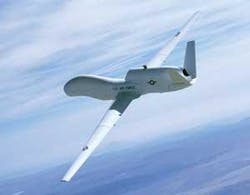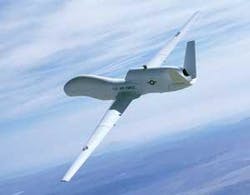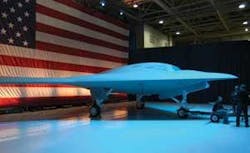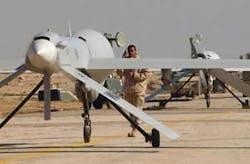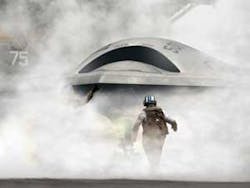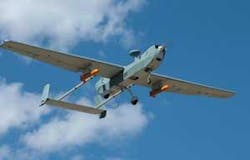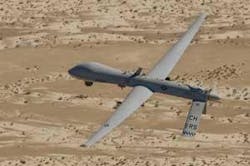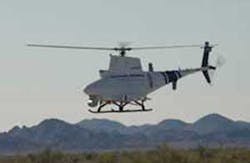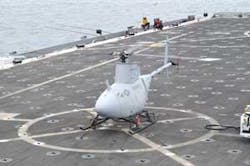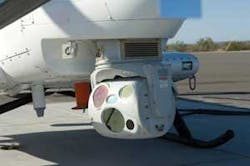Unmanned aerial vehicles get ready for prime time
The use of unmanned aerial vehicles (UAVs) for military applications is more important than it has ever been, and government leaders are sharing ideas with UAV designers to broaden their use not only in wartime conflicts, but also for border control, emergency response, law enforcement, and forest fire surveillance.
By J.R. Wilson
In the past two decades, unmanned aerial vehicles (UAVs) have evolved from little more than cameras attached to remote-controlled airplanes to sophisticated long-duration airborne sensor suites that also can kill many targets they discover–but only by command of a human operator.
With the Obama administration ending production of the F-22 Raptor jet fighter, shelving plans for a new long-range bomber and attack helicopter, and laser-focusing the U.S. military to use technology to do more with less, the prospects for continued UAV evolution may be higher than ever.
“We’re at a real time of transition here in terms of the future of aviation and the whole issue of what’s going to be manned and what’s going to be unmanned,” Joint Chiefs Chairman Adm. Michael Mullen told the Senate Armed Services Committee in May.
“There are those that see JSF [the F-35 Joint Strike Fighter] as the last manned fighter...and I’m one that is inclined to believe that. I don’t know if that’s exactly right, but this all speaks to the change that goes out obviously decades, including how much unmanned we’re going to have and how it’s going to be resourced.”
Kyle Snyder, director of knowledge resources at the Association for Unmanned Vehicle Systems International (AUVSI) in Arlington, Va., says the revolution is complete in making UAVs an integral, permanent, and significant part of military operations. Now, he adds, “it’s just a question of taking the evolutionary steps to achieve the future versions.
“We’ll never see unmanned dog fighting, because there really isn’t a need for that kind of combat, but we will see persistence UAVs, whether an airship that remains aloft for years at a time or a family of vehicles that can always provide eyes-in-the-sky on a rotation basis or even an airborne carrier that can host and launch UAVs as needed. There is a use for that and the technology will be there to do that, probably with an unmanned launch platform,” Snyder says.
“On the commercial side, I think we will see the same kinds of transitions we’ve seen on the military side–ISR [intelligence, surveillance, and reconnaissance] for security surveillance will be the first big application, with transitions from the border patrol folks, who already are using UAVs, to the commercial sector for port security or event security, such as a planned festival, or an unplanned need, such as a hurricane. Having that ability available is important.”
Not everyone agrees with Snyder’s dismissal of a “dog-fighting” unmanned combat air vehicle (UCAV), yet the kind of air-to-air capability such a platform should possess differs substantially from the kind of aircraft dog fighting seen in World War II. The last time the U.S. actually faced a direct air-to-air challenge from an enemy with anything close to comparable capability was during the Korean War more than a half century ago when early-model jet fighters faced off in the so-called “MiG Alley” area over the Yalu River Valley. Since then, the primary challenge to U.S. air superiority has been surface-to-air missiles, targets current UAVs already are designed to destroy, either directly or by acting as target designators.
UAVs in future conflicts
No other nation has–or is likely to have–a fifth-generation fighter like the F-35 within the next two decades, except those allies who acquire the F-35 from the U.S. The F-22, the world’s only other fifth-generation fighter, has never been offered for foreign sales.
Still, future conflicts might see U.S. air superiority challenged by enemy aircraft–manned or unmanned. As the U.S. puts greater reliance on its own UAV fleets–especially any future sixth-generation UCAV operating in place of a manned fighter–the greater is the need for those platforms to engage and defeat enemy aircraft–perhaps not in a close-quarters dogfight, but at standoff distances well before an enemy aircraft even knows a threat exists, as current manned fighters do.
Meanwhile, the U.S. Department of Defense (DOD) is pushing forward with current and emerging UAV technologies to augment and replace manned aircraft. Defense Secretary Robert Gates points out, however, that this process involves not only a reshaping of military concepts, but also consideration for the status and future of the U.S. defense industry.
“Our struggles to put the defense bureaucracies on a war footing these past few years have revealed underlying flaws in the priorities, cultural preferences, and reward structures of America’s defense establishment–a set of institutions largely arranged to prepare for conflicts against other modern armies, navies, and air forces,” Gates told the House Armed Services Committee (HASC) on 13 May. “Our contemporary wartime needs must receive steady long-term funding and must have a bureaucratic constituency similar to conventional modernization programs and similar to what I have tried to do with programs to support our troops. The FY10 budget reflects this thinking.
“First, we will increase ISR support for the warfighter in the base budget by some $2 billion. This will include fielding and sustaining 50 Predator-class unmanned aerial vehicle orbits by FY11 and maximizing their production. This capability, which has been in such high demand in both Iraq and Afghanistan, will now be permanently funded in the base budget. It will represent a 62 percent increase in capability over the current level and 127 percent from over a year ago.”
In his appearance before HASC the next day, Adm. Gary Roughead, chief of naval operations, said the U.S. Navy is investing in new and proven technologies to address its aviation capability and capacity requirements.
Planning for the future
“In addition to manned aviation, our Navy is investing in unmanned aircraft, such as Fire Scout [Northrop Grumman MQ-8], which is more affordable, can be built in larger numbers, and can do the missions needed in the small wars and counterinsurgencies we are likely to face in the near to mid-term. We are also investing in the Broad Area Maritime Surveillance System [BAMS], which is the only unmanned aircraft that can provide long-range ISR in the maritime environment. Our aviation programs increased by more than $4.2 billion from FY2009 to FY2010 to achieve the right balance of capability and capacity,” Roughead told lawmakers.
“The BAMS UAS enhances situational awareness of the operational environment and shortens the sensor-to-shooter kill chain by providing persistent, multiple-sensor ISR to fleet commanders and coalition and joint forces," Roughead said. "Our FY2010 budget requests funding for continued research and development of BAMS. We are also requesting funding for the procurement of five MQ-8 Vertical Takeoff and Landing Tactical UAVs [VTUAV]. The MQ-8 supports LCS [Littoral Combat Ship] core mission areas of ASW [anti-submarine warfare], mine warfare, and SUW [surface warfare]. It can operate from all air-capable ships and carry modular mission payloads to provide day and night real-time reconnaissance, surveillance, and target acquisition capabilities. VTUAV began operational testing this March aboard USS McInerny.”
The Marine Corps also is expanding UAV implementation in current combat operations, including standing up a fourth UAV squadron, further cementing the Corps’ reliance on unmanned platforms.
“When fully fielded, the Corps’ unmanned aerial systems will be networked through a robust and interoperable command and control system that provides commanders an enhanced capability applicable across the spectrum of military operations. Revolutionary systems, such as those built into the Joint Strike Fighter, will mesh with UAS to give a complete, integrated picture of the battlefield to ground commanders,” Corps Commandant Gen. James T. Conway told HASC. “In Iraq and Afghanistan, the Marine Corps is currently using an ISR services contract to provide [Boeing] ScanEagle systems to our forces, but we anticipate fielding Small Tactical UAS [STUAS], a combined Marine Corps and Navy program, in FY2011 to fill that void at the regiment and Marine Expeditionary Unit level. In support of battalion-and-below operations, the Marine Corps is transitioning from the Dragon Eye to the joint Raven-B program [RQ-11B, manufactured by AeroVironment in Monrovia, Calif.]”
Neal Blue, chairman and chief executive officer of General Atomics Aeronautical Systems in San Diego, which produces the Predator and its follow-on cousins–the MQ-9 Reaper and Predator C Avenger–says he believes the key to further development, at least in the near future, centers on advancing situational awareness. That covers the UAV’s ability to see and identify what is going on around it as well as deliver useful, comprehensive real-time information to human warfighters to enhance their situational awareness. As has been the case in making current UAVs critical to military operations, that will depend on continued integration of other technologies to make possible what was not possible before.
UAV sensors
“The application of radar is just beginning to be appreciated in terms of what it will provide. If you start with the Lynx [synthetic aperture] radar, you have a wide-area GMTI [ground moving target indicator] able to surveil about 9000 square kilometers per hour, which vastly transcends the ability to surveil by any optical system. Combine that with target location and you achieve a capability that fulfills Air Force Small Diameter Bomb placement and other GPS weapons, so you are not dependent on weather or the shorter range of laser designation,” Blue says.
“The Lynx system now has demonstrated, under a DARPA program [Lynx Dual Beam Dismount Detection], to identify dismounts at 1 meter per second or 2 miles per hour in terms of understanding what’s happening on the ground, in all weather conditions, 24/7, which is very important,” Blue says. “For GMTI, it is important to see individuals walking; the currently installed Lynx on the MQ-9 has a capability of only about 7 meters per second, so you would miss those dismounts, which are important to manned forces on the ground.”
The Multi-Spectral Targeting System (MTS-B) electro-optical/infrared (EO/IR) sensor on the Reaper has been converted to a high-definition system providing digital, high-resolution, full-motion video. Other significant sensor developments cited by Blue include wide-area surveillance and a very wide field of view capability providing muzzle flash detection and extremely precise location.
“Just as important as the integration of the airborne sensor suite, however, is the ability to use much higher bandwidth to get high-fidelity programmable imagery and for process and distribution,” Blue adds. “We have another internally funded activity for development of a completely stealth EWB [exponential wideband] downlink at 76 megabits per second with 100 nautical mile range. The key is not only high bandwidth and high resolution, transcending the amount of bandwidth available on satcom, but is also being completely undetectable in ultra-wide bandwidth waveforms.”
Also integral to this enhanced level of sensor data gathering and transmission is an open-architecture system to provide universal access and interoperability among the different systems used by the U.S. military and its allies and coalition partners.
“This system controls multiple platforms, weapons delivery systems, and payloads–sensors. You also need connectivity to multiple users, with different classification levels. So you have a full distributed ground system, integrated backbone, multi-level security control, full integration with C4I nets–including Link-16, AIS [Automatic Identification System] radio navigation, and a variety of others–multiple live and cached feeds, and a product that is an automatic search and display of an area of interest on demand,” Blue says. “This stuff is both near-term and fairly cheap.
Situational awareness
“All these systems aggregate to a certain situational awareness-deliverable capability, which needs to be and will be radically enhanced as better systems are employed in the future," Blue says. "Imagine those systems having better granularity and range, making each platform more efficient in terms of useful pixels it can deliver, as well as better data reception, control, and dissemination of megabytes of information, which will improve to a point where situational awareness is a really accurate characterization of an area of interest. Or the area of interest can be expanded effortlessly to a required larger dimension.”
All of this also merges with future UAV weapons developments, from kinetic kill to directed energy. The real question, says Lindsay Voss, an aerospace and defense industry analyst with Frost & Sullivan in Mountain View, Calif., is whether DOD and industry will pursue the right combination of vehicles, sensors, weapons, and ground stations to deal with events beyond the current war in Southwest Asia.
“What will happen when we have the next big threat or war? Will we still need ISR capability or something else? How will UAV technology transition to meet those needs? Can industry–which quickly came to the table with current solutions–carry it forward to meet that next requirement?” Voss asks.
UAV spending
“This has emerged so quickly, in terms of defense technology, that there are still a lot of operational gaps and reliability questions," Voss explains. "How much more and how quickly can it progress and change? Will the technology continue to be relevant? Industry, of course, says it will be relevant and they will be able to change with the need; DOD, however, still has questions.”
The 2010 DOD budget also looms over those questions. The U.S. military forces plan to spend nearly $5.4 billion next year on unmanned vehicle (UV) technology for air, ground, and maritime applications. The Pentagon’s unmanned vehicles spending plan for next year consists of $3.55 billion for procurement, up 16.16 percent from 2009, and $1.82 billion for research, development, test, and evaluation (RDT&E), up by 23 percent from 2009 levels.
Part of the Pentagon’s UAV budget will be used to procure additional current platforms, primarily the Predator and Reaper. Another part will go to sustaining legacy platforms, part of a growing services sector that really emerged as a significant requirement in 2008, according to Voss.
“How we will support these platforms has become increasingly important, so I suspect a good chunk of future DOD budget money for UAVs will go toward those requirements, in addition to procurement,” Voss predicts. “There will be funds for R&D, but there is a concern in industry and the defense labs that, if money is cut, the easiest place to take it from is R&D, especially for programs still in the developmental phase, such as UCAVs. If those are not needed today and the government is looking for places to cut, things like that become easy targets.”
While UAVs have become accepted parts of today’s combat theater–as well as in civilian applications, from border patrol to monitoring forest fires–UCAVs have become fodder for Hollywood exaggerations and considerable public confusion. Far from the self-minded killing machines of the Terminator movies or the rogue UCAV featured in the movie Stealth, current UCAV concepts share one prime factor with today’s UAVs: They are controlled by a human pilot on the ground.
Human in the loop
“Human-in-the-loop” is a constant no current military–much less civilian–leader is willing to abandon. In many respects, the MQ-9 Reaper, the first UAV built from scratch to be a hunter/killer, is a first-generation UCAV. The primary difference with future platforms officially designated as UCAVs will be the degree of autonomy and artificial intelligence (AI) they employ.
AI also is a term that raises red flags for many people, again largely due to movie and TV depictions of talking, self-aware robots. In reality, at current and near-term computer capabilities, AI is closer to a computer being able to distinguish a dog from a cow or properly mix the ingredients for jambalaya than to think–in human terms–and take action beyond its programming or without human direction.
This is not to say there are not valid concerns that must be addressed before a true UCAV achieves the level of integration and acceptance now given UAVs, including hunter/killers at the Reaper level.
“From the perspective of general acceptance, a lot of people don’t know or understand the concept of a human-in-the-loop,” Voss says, but adds there are divides even among those who do. “The technology has progressed to the point where it is very much like playing a video game–and that can create a pretty big disconnect. You have situational awareness, but it is not as great as actually being in the cockpit or holding a weapon and getting ready to fire.
“The goal with a weaponized Predator is to have the same situational awareness as a piloted aircraft, but the Army doesn’t use combat pilots who have been trained to do that and have flown manned fighter aircraft. From what I’ve heard discussed, that is one of the things that can hold it back. Money will always be the biggest factor, but that remains a key element, perhaps bigger than DOD might want to admit,” Voss says.
Some argue there is no immediate need to push forward with UCAVs because no other country on Earth–possible enemy or ally–can match what the U.S. has fielded or will be able to field in the next few years. But in a world of rapid technological advances–and a growing disparity between the number of U.S. citizens and foreign nationals holding science and engineering degrees–that also is a topic for hot debate.
“There may be some arrogance that says let others develop this capability because they still won’t ever be able to compete with us. Of course, we are always developing products the general public doesn’t know about,” Voss says. “So, realistically, there really hasn’t been that big of a push for these platforms based on a concern that we won’t be competitive if we don’t do it. That could change, of course, but from the standpoint of what everyone knows about, it will be more about whether the U.S. wants to fund it or needs to fund it–maybe because there already are black programs in development or in place.
“From what I’ve seen in terms of money invested, nothing even comes close to what the U.S. is investing on the R&D side–which even here is not crazy amounts of money–or on the procurement side, where nobody rivals us. Maybe that is arrogance or even stupidity on our part that we are not more concerned, but everyone seems far more enamored of the capabilities coming out of the U.S. than what anyone else is doing," Voss continues. "And until someone actually proves something, what they have tends to be knock-offs of what we already have.
“Will people look at it differently in 10 years, when perhaps we have more UAVs in the battle theater than manned aircraft? That’s hard to predict. If you look at the technology we have now and the issues that exist, along with the cultural concerns, making a prediction that it might be fielded within 10 years is a long shot," Voss says. "The majority of people, I would say, remain hesitant and skeptical.”
